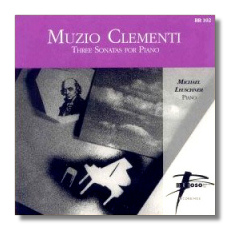
The Internet's Premier Classical Music Source
Related Links
- Clementi Reviews
- Latest Reviews
- More Reviews
-
By Composer
-
Collections
DVD & Blu-ray
Books
Concert Reviews
Articles/Interviews
Software
Audio
Search Amazon
Recommended Links
Site News
 CD Review
CD Review
Muzio Clementi

Piano Sonatas
- Piano Sonata in D Major, Op. 40 #3
- Piano Sonata in G minor, Op. 7 #3
- Piano Sonata in D minor, Op. 50 #2
Michael Leuschner, piano
Produced by Maija Nabering and Pit van Bergen
Brioso BR102 DDD? 52:30
The position of Muzio Clementi (1752-1832) in the development of the piano sonata has been largely overlooked, even if plenty of us remember his name from sonatinas we had to plough through in our early piano lessons. The sheer scale of his output is impressive enough: among the piano music alone Baker's lists 106 sonatas (46 of them with violin, cello or flute), and there is also a healthy quantity of smaller pieces, many of them intended for teaching, the best-known being his collection of studies entitled Gradus ad Parnassum. (And there's a horrifying tale of George Grove visiting Clementi's nephew, a vicar in south-east England, to enquire about the music – at which point they discovered that the maid had been using Clementi's manuscripts to light the fire.)
But it's the sheer quality of the music which continues to elicit admiration. The dignified opening of the D Major Sonata, Op. 40, #2 (published in 1802) which begins this admirable disc points to how strongly Clementi foreshadowed the coming of the Romantic era: it sounds like nothing so much as late Schubert, but then retreats swiftly to Classical patterns, which it nonetheless threatens to ignore. The G minor Sonata, Op. 7, #3, which according to Leon Plantinga's notes dates from 1780-85, then reveals that this tendency to push against convention was with him early, though. The D minor Sonata, op, 50, #3, like the two others in three-movement form, begins boldly and big-boned, again hinting at emotions that only just sit in within its demure classical framework, though it's not quite as adventurous as the earlier (or is it? in this period opus numbers were rarely reliable guides to dates of composition) D Major work.
Incidentally, Charles Rosen, in his Sonata Forms (Norton, 1988) singles out the D Major Sonata for "the wittiest use of this movement from V of vi to the recapitulation […], an effect as poetic as it is ingenious"; and it was Rosen, in his earlier The Classical Style (Faber, 1971) who put his finger on Clementi's historical importance:
"Clementi […] stands somewhat apart [from Haydn and Mozart], both in his fusion of Italian and French tradition and in his development of the virtuoso passagework so essential to the post-classical style of Hummel and Weber. […] this kind of passagework […] was to be given artistic importance by Liszt and Chopin."
Michael Leuschner has discovered exactly the right approach to Clementi's music: he knows just how much to respect its Classical norms, and how much to realise the proto-Romantic sentiment hiding its textures. He is given a clear and sturdy recorded tone. Incidentally, there's a banding error: the three movements of the D Major indicated as separate tracks get squeezed onto two, so that all the rest is one out. And a puzzled query: why did Brioso choose to set Plantinga's notes in upper case throughout? It makes them damned hard to read. Recommended nonetheless.
Copyright © 1993/1996, Martin Anderson


















